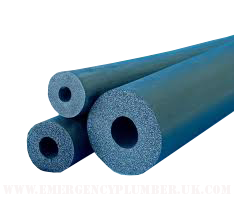Insulating your loft, hot water pipes and hot water cylinders can save you hundreds of pounds

Pipe Lagging
The results of research by the National Physical Laboratory (NPL) have revealed that the insulation in your loft might not be as efficient as you think.
Topping up your loft insulation could save you £££s
Many people insulate their loft – and with good reason, a large proportion of heat and thus energy, is lost through the roofs of homes across the UK. Because of this the government has introduced a variety of schemes which are aimed at homeowners and designed to increase energy saving awareness. In some cases these schemes also help homeowners with the costs of installing insulation in their lofts and in other areas in the home.
The study done by NPL highlights the problems with lack of loft insulation and the problems encountered when the insulation is compressed if the loft area is used for storage.
With storage space a problem for homeowners, many resort to storing items in the loft. And while this can be a good idea in terms of utilising the available space, the installation of boarding over any loft insulation can actually reduce it’s effectiveness as a heat insulator.
If you’ve boarded your loft you could be reducing your thermal heat efficiency
The Carbon Trust recommends that 270mm of insulation should be fitted into a loft space. However because around 65% of people have fully or partially boarded their loft for storage, they are missing out on the energy savings they should be making. Because loft joists are typically 100mm high commonly this is also the height of the insulation – nowhere near the Carbon Trust’s recommendations – that is fitted between the boarding and the ceiling in the rooms below.
If you’ve not got the required thickness of insulation in your loft it might be worth looking at the alternative methods of insulating your loft to reduce heat loss.
Got the loft sorted? Install insulation on hot water pipes
While the NPL study focuses on loft insulation, The Emergency Plumber Company recommends that homeowners take a look at other types of insulation in their home – primarily the insulation on hot water pipes and cylinders.
Information from the Energy Saving Trust shows that energy savings equivalent to around £15 per year can be had just by insulating hot water pipes. However these are figures for a standard sized home and larger homes will undoubtedly see greater benefits.
Emergency Plumbers visit thousands of homes every year and it’s staggering how many of these homes don’t have foam insulation fitted to their hot water supply pipes and central heating pipes. When these pipes run under floors or in cellars it’s easy to see how the heat in these pipes is quickly lost after the boiler is turned off.
Insulated the hot water pipes? Time to fit a hot water cylinder jacket
One of the easiest ways to save energy on a hot water system is to install a thermal jacket to your hot water cylinder. The Energy Saving Trust recommends a thickness of at least 75mm and if you fit your cylinder with a new winter coat you can expect to see energy savings amounting to around £45 per year, with a massive heat loss reduction of 75%. Look for a British Standard cylinder jacket as these should meet BS 5615 standards.
With energy costs continuing to rise it’s important for homeowners to do everything they can to save energy and reduce their heating bills – and adding insulation is one of the best ways to do this.

